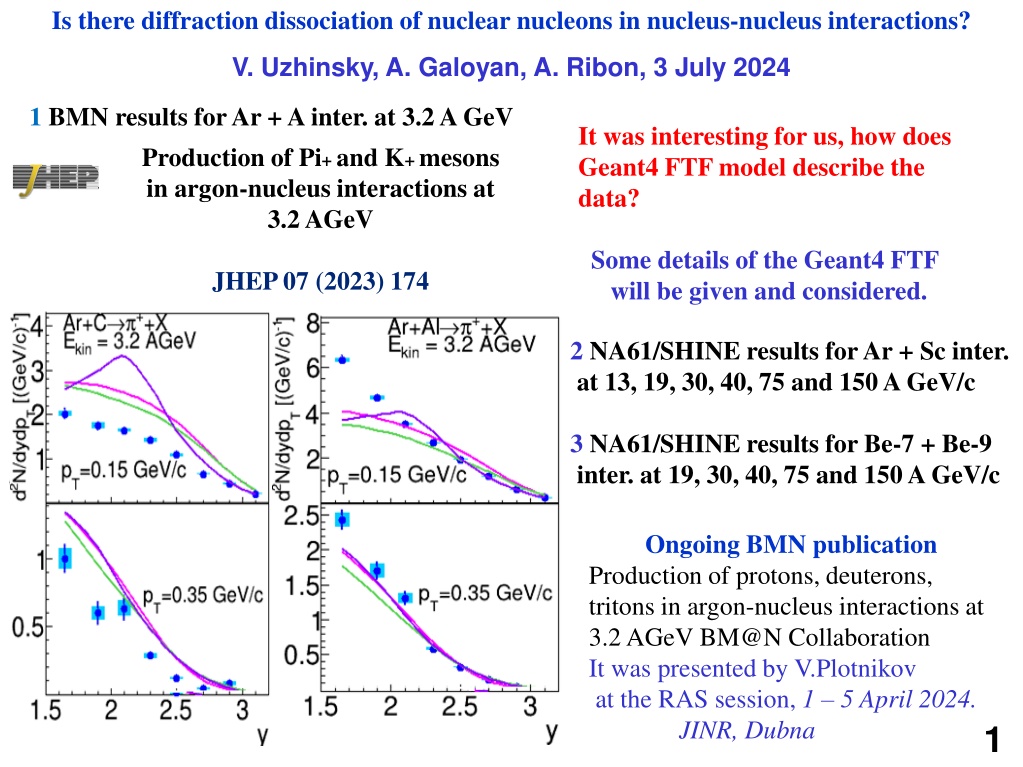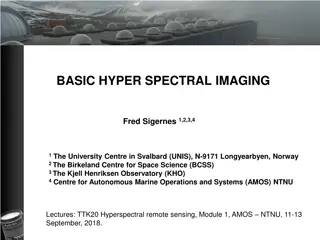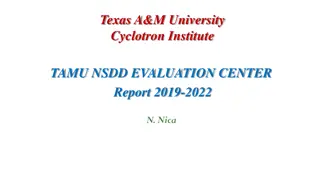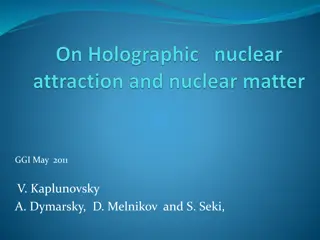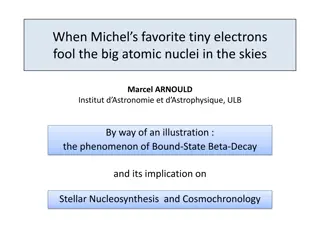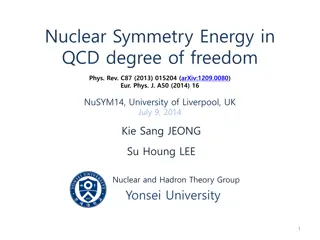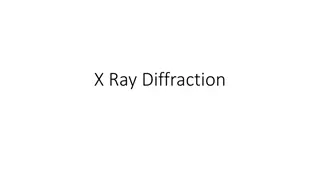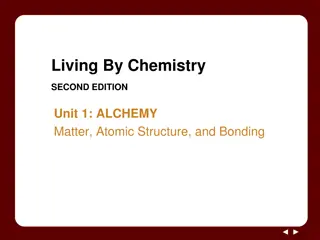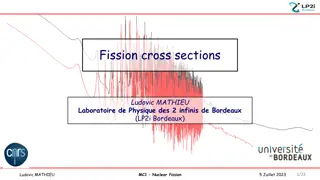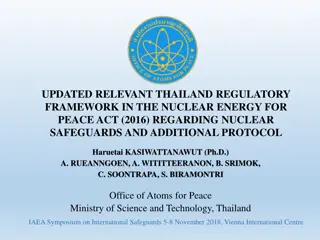Understanding Diffraction Processes and Meson Production in Nuclear Interactions
Exploration of diffraction dissociation of nuclear nucleons in nucleus-nucleus interactions using Geant4 FTF model and NA61/SHINE results for various nucleus combinations. Insights into meson production in argon-nucleus interactions at different energies and the impact of models like DCM/AGT, UrQMD, and PHSD. Comparison of BMN results for different target materials and the effectiveness of New FTF model. Examining the Geant4 FTF model's basic assumptions and string creation processes. Simulation of inelastic nucleon-nucleon interactions and diffraction processes in proton-proton interactions. Important references to Pomeron theory and factorization in hadronic diffraction.
Download Presentation

Please find below an Image/Link to download the presentation.
The content on the website is provided AS IS for your information and personal use only. It may not be sold, licensed, or shared on other websites without obtaining consent from the author. Download presentation by click this link. If you encounter any issues during the download, it is possible that the publisher has removed the file from their server.
E N D
Presentation Transcript
Is there diffraction dissociation of nuclear nucleons in nucleus-nucleus interactions? V. Uzhinsky, A. Galoyan, A. Ribon, 3 July 2024 1 BMN results for Ar + A inter. at 3.2 A GeV It was interesting for us, how does Geant4 FTF model describe the data? Production of Pi+ and K+ mesons in argon-nucleus interactions at 3.2 AGeV Some details of the Geant4 FTF will be given and considered. JHEP 07 (2023) 174 2 NA61/SHINE results for Ar + Sc inter. at 13, 19, 30, 40, 75 and 150 A GeV/c 3 NA61/SHINE results for Be-7 + Be-9 inter. at 19, 30, 40, 75 and 150 A GeV/c Ongoing BMN publication Production of protons, deuterons, tritons in argon-nucleus interactions at 3.2 AGeV BM@N Collaboration It was presented by V.Plotnikov at the RAS session, 1 5 April 2024. JINR, Dubna 1
BMN results for Ar + C and Ar + Al DCM/AGT model: local simulations of NN channel cross sections like P+P -> N Pi+ P. No Deltas! (P+P -> P + + -> P + N + Pi+) UrQMD local simulations of NN inter. Using matrix elements. No Delta formation time and size! PHSD based on Fritiof 7.0 at high energies and UrQMD at low energies. 2
BMN results for Ar + C and Ar + Al Red lines default FTF model, blue ones new FTF C target, OK, Al not OK. What is the matter? Blue lines (suppressed DD) OK for Al and heavy A! 3
BMN results for Ar + Cu, Sn and Pb Red lines default FTF model, blue ones new FTF New FTF works better than other models. 4
Geant4 FTF model : basic assumptions B.Andersson et al. Nucl. Phys. B281 289 (1987) B.Nilsson-Almquist, E.Stenlund, Comp. Phys. Comm. 43 387 (1987). Fig. 1: Processes of string's creations considered in the FTF model. Str. Str. GS GS Str. Str. Fig. 2 Additional quark exchange processes in the FTF model. String mass distribution 5
Simulation of inelastic nucleon-nucleon interactions Fritiof model UrQMD Md=1.46 Fritiof 1.6 Md=1.2 Fritiof 7.0 Md=1.2 Hijing Md~2; FTF 1.16 6
Diffraction processes in PP interactions Diffractive Production Mechanisms A.B. Kaidalov, Phys. Rept. 50 (1979) 157, cited 289! This is the triumph of the Pomeron theory K. Goulianos and J. Montanha, Factorization and scaling in hadronic diffraction, Phys. Rev., D 59 (1999) 114017 CDF data, Solid lines -- calculations 7
Diffraction processes in PP interactions Diffractive processes (~ 40 %) and quark exchange ones are very important at low energies (NICA)! Single diffraction dissociation cross section in ??-interactions. Points are data gathered by K. Goulianos and J. Montanha [GM99]. Lines are FTF model calculations. (Physics Reference Manual, Release 11.1 Geant4 Collaboration Rev7.0: December 9th, 2022 https://geant4-userdoc.web.cern.ch/UsersGuides/PhysicsReferenceManual/html/index.html) 9
What has to be done in nucleus-nucleus interactions? States of hadrons in FTF Secondary Interactions? 1. 2. 3. 4. 5. Quark exchange (GS + GS, QE) Quark exchange with excitation (GS + TrD or PrD + GS, QE) Projectile diffractive excited (PrD) Target diffractive excited (TrD) Non-diffractive interactions (Str. + Std., ND) Target/ Project. GS PrD Str. GS Qe PrD TrD ND PrD TrD ND ND TrD PrD TrD ND PrD TrD ND ND Str.. ND ND ND New algorithm of DD accounting 10
NA61/SHINE data on Ar-40 + Sc-45 and FTF model 10 % centrality. Bmax = 2.87 fm Measurements of ? , ? , p and anti-? spectra in40Ar+45Sc collisions at 13A to 150A GeV/c NA61/SHINE Collaboration (H. Adhikary et al.)l Eur. Phys. J.C 84 (2024) 416 These first results encouraged us! Now we can reproduce (~) results of other model in Geant4 FTF one! It is very good! 11
NA61/SHINE data on Ar-40 + Sc-45 and FTF model 10 % centrality. Bmax = 2.87 fm, Pi+ Now we can reproduce (~) results of other model in Geant4 FTF one! It is very good! Of course, it is not good that the data do not cover the central region. 12
NA61/SHINE data on Ar-40 + Sc-45 and FTF model 10 % centrality. Bmax = 2.87 fm, Pi- Now we can reproduce (~) results of other model in Geant4 FTF one! It is very good! 13
NA61/SHINE data on Be-7 + Be-9 and FTF model 20 % centrality. Bmax = 1.92 fm, Pi, Protons There is a space for improvement of the Geant4 FTF model. 14
Summary 1. The new algorithm of accounting of the nuclear nucleon diffraction dissociation in nucleus-nucleus interactions has been proposed. It allows to improve FTF results. 2. Good results have been obtained for heavy nuclei. 3. There is a problem of description of interactions with light nuclei. 4. It is almost unclear, how to reach a description of K- meson production in Ar-40 + Sc-45 interactions? 15
NA61/SHINE data on Be-7 + Be-9 and FTF model 20 % centrality. Bmax = 1.92 fm, Pi, Protons We hope a small tuning will be need for a description of the data! 16
Questions to think about 1. Model predictions for Ar + C? 2. Exp. points at y = 1.65? 3. Large scattering of model predictions for K mesons in Ar + A interactions? What about Pi- and K- (Propan)? 4. Strong leading particle effect in FTF for proton production? 5. Pauli blocking in QGSM and FTF? 6. DD and Pauli blocking in models? 7. K meson production in Ar + Sc? 8. Condensed baryonic matter? 17
